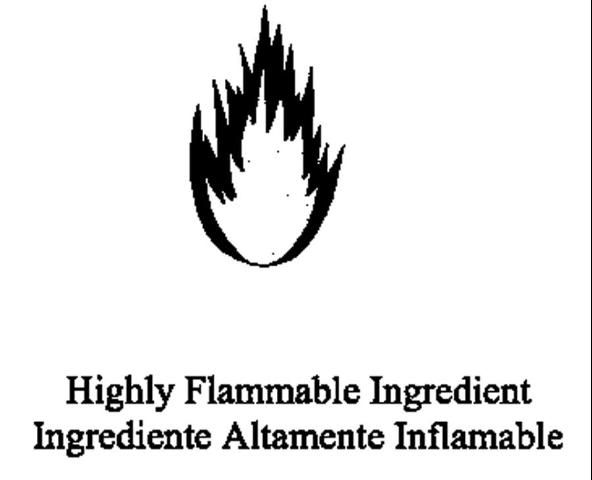This document interprets physical or chemical hazards seen on pesticide labels and discusses criteria used in determining the appropriate hazards for the pesticide. Examples of typical statements found on pesticide labels which convey information to the handler of the product are provided.
Introduction
A pesticide handler for a large commercial agricultural commodity producer unloads a pallet of 5-gallon pesticide containers from a delivery truck with his forklift. The pesticides contain petroleum distillates as part of their inert ingredients. The handler unknowingly places the pallet adjacent to a furnace on an unseasonably cold January morning. Late that evening, a ringing telephone awakens the agricultural establishment's manager and learns from the local emergency response crew that their pesticide storage facility is on fire. Because of environmental considerations with contaminated runoff water from pesticides, the manager is told that the fire will have to burn itself out rather than be put out with conventional methods. Besides the pesticides that were purchased and delivered that morning, more than $100,000 worth of inventory is destroyed.
Such disasters can be avoided by reviewing the label of the pesticide. The label will address flammability, explosive potential, and other precautions regarding physical or chemical hazards.
Where are the physical or chemical hazards found on the label?
If a product has specific physical or chemical hazards, they will be listed immediately below the "Hazards to Humans and Domestic Animals" statements and "Environmental Hazards" statements in the "Precautionary Statements" section of the label. It will bear the subheading "Physical or Chemical Hazards."
Labeling for Flammable Products
Certain testing criteria determine if a product must bear flammability statements. Testing involves determining the flash point and flame extension of a product. The flash point is the lowest temperature at which a liquid product containing a combustible ingredient that gives off a flammable vapor will ignite. A flame extension test is required for aerosol products. The flame extension test is conducted by holding the aerosol can 6 inches from a flame and discharging the product across the flame. The extension of any flame from the flame source (typically a candle) in inches is noted and recorded. Any flame extension more than 18 inches or any flashback of flame to the valve at any degree of valve opening would then dictate the proper labeling of the product as either being flammable or extremely flammable (Table 1). Flashback occurs when the flame is drawn back toward the aerosol can by the stream of propellant. This would indicate an extremely flammable product.
The human hazard signal words CAUTION, WARNING, and DANGER are not used with flammability statements in order to prevent any confusion. For example, if the product is a total release fogger containing a propellent with a flash point at or below 20°F, the following label statement must be included in the "Physical or Chemical Hazard" section: "This product contains a highly flammable ingredient. It may cause a fire or explosion if not used properly. Follow the Directions for Use on this label very carefully." In addition to the wording, a symbol indicating a highly flammable ingredient will be displayed in this section (Figure 1).

Declaration of Non-Flammability
Certain products may bear a claim of non-flammability, with terms like "non-flammable" or "non-flammable gas, liquid, etc." Products that bear non-flammability claims do so by meeting the following criteria:
-
If a gas or mixture of gases: the product must not ignite when a lighted match is placed against the open cylinder valve.
-
If a liquid: the product must have a flash point greater than 350°F.
The phrases "non-flammable," "non-flammable gas" or "non-flammable liquid," may appear as a sub-statement to the ingredients statement, or on the back or side panel.
Labeling for Liquid Products Used Near Electrical Equipment
If the product is labeled for use around electrical equipment or electrical outlets and a shock hazard exists, a statement is included in the physical or chemical hazards statement: "Do not apply this product around electrical equipment due to the possibility of shock hazard."
Labeling for Explosive Potential
Pesticides that have specific statements for potential explosion hazard include, but are not limited to: sulfur and carbon dust, potassium and sodium nitrate, and potassium chlorate. Each product label will address the specific concern regarding its use pertaining to explosion hazard.
Fumigant Hazards
Some fumigants are potentially explosive and flammable. Others, form toxic gases when exposed to moisture.
Miscellaneous Physical or Chemical Hazards
Some pesticide products have physical or chemical hazards other than flammability or explosive potential. These products may have to address such hazards as oxidizing or reducing capability, reactivity, or corrosiveness.
Additional Information
Fishel, F.M. 2005. Interpreting Pesticide Label Wording. PI-34. Gainesville: University of Florida Institute of Food and Agricultural Sciences. https://edis.ifas.ufl.edu/P1071
Fishel, F.M. 2008. EPA Approval of Pesticide Labeling. PI-167. Gainesville: University of Florida Institute of Food and Agricultural Sciences. https://edis.ifas.ufl.edu/PI203